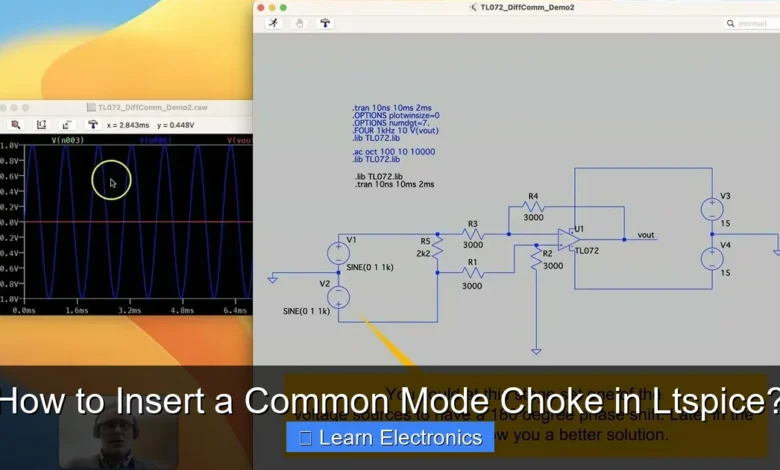How to Insert a Common Mode Choke in Ltspice?

How to Insert a Common Mode Choke in LTspice? You can effectively model a common mode choke in LTspice by using two coupled inductors, establishing their mutual inductance via a K-statement. This method accurately simulates the device’s behavior in filtering unwanted noise in your electronic circuits.
Understanding this practice is crucial for engineers and hobbyists alike, as it enables the precise simulation of noise suppression components, leading to more robust and compliant designs.
Quick Answers to Common Questions
How do I actually add a common mode choke in LTspice?
It’s simpler than you think! You’ll start by placing two standard inductors (L) in your schematic, one for each line. Then, you’ll define their coupling using a ‘.k’ statement with a high coupling coefficient to create your common mode choke.
What’s the most important parameter for modeling a common mode choke in LTspice?
The magic really happens with the coupling coefficient, specified by the ‘K’ statement. This value, typically very close to 1 (like 0.999 or 0.9999), tells LTspice how effectively your common mode choke’s two windings are coupled.
How can I make my common mode choke model more realistic in LTspice?
To go beyond an ideal common mode choke, consider adding series resistors (R) to each winding for DCR and even small parallel capacitors (C) across them to represent parasitic capacitance. This gives you a more accurate simulation!
📑 Table of Contents
- Understanding Common Mode Chokes and Their Role
- Essential Concepts for Modeling Inductors in LTspice
- Step-by-Step Guide: How to Insert a Common Mode Choke in LTspice
- Configuring Common Mode Choke Parameters
- Practical Example and Simulation Setup
- Troubleshooting and Optimization for Common Mode Chokes in LTspice
Understanding Common Mode Chokes and Their Role
Before diving into the simulation process, it’s essential to grasp what a common mode choke is and why it’s a critical component in many electronic designs. These specialized inductors play a vital role in electromagnetic compatibility (EMC) by suppressing common mode noise.
What is Common Mode Noise?
Common mode noise refers to unwanted signals that appear equally on all lines of a multi-conductor cable or circuit, relative to a common reference (like ground). Unlike differential mode noise, which is a voltage difference between two lines, common mode noise typically radiates from the cable itself, acting as an antenna, or couples into the system from external sources. It can interfere with other electronic devices, cause data errors, or even lead to system instability.
Why Use a Common Mode Choke?
A common mode choke is designed specifically to impede these common mode currents while allowing differential mode signals (the intended data or power) to pass through with minimal attenuation. It achieves this by winding two (or more) coils onto a single magnetic core. Common mode currents flow in the same direction through both coils, generating magnetic fields that add constructively, creating a large impedance. Conversely, differential mode currents flow in opposite directions, producing magnetic fields that cancel each other out, resulting in very low impedance. This selective impedance makes them indispensable for power supply filtering, data line filtering, and compliance with EMC standards.
Essential Concepts for Modeling Inductors in LTspice
Modeling any inductive component accurately in a simulator like LTspice requires an understanding of both ideal and real-world characteristics. This is particularly true for coupled inductors like those forming a common mode choke.
Ideal Inductors vs. Real-World Components
An ideal inductor in a simulator would simply present an impedance proportional to frequency, with no losses or parasitic effects. In reality, inductors have series resistance (ESR), parallel capacitance (parasitic capacitance), and can exhibit non-linear behavior like saturation at high currents. For basic common mode choke modeling, we often start with ideal coupled inductors and then add parasitic elements as needed for greater accuracy.
Inductor Parameters in Simulation
When simulating inductors, the primary parameter is inductance (L), measured in Henrys (H). For coupled inductors, the mutual inductance between them is also critical. In LTspice, this is handled through the coupling coefficient (K), which defines how strongly two inductors wound on the same core interact magnetically. A K-value of 1 indicates perfect coupling, while a K-value of 0 means no coupling. For a common mode choke, a high K-value (typically 0.95 to 0.999) is desired for optimal common mode impedance.
Step-by-Step Guide: How to Insert a Common Mode Choke in LTspice
The most common and effective method to model a common mode choke in LTspice involves using two individual inductors and then coupling them together. This section details the process.
Method 1: Using Coupled Inductors (K-statement)
- Place Two Inductors: Open your LTspice schematic and add two standard inductor symbols (F2 >
ind). Label them, for example,L1andL2. - Assign Inductance Values: Right-click on each inductor and set its inductance value (e.g.,
100ufor 100 microhenries). Ensure both inductors have the same value for a symmetrical common mode choke. - Add a K-statement for Coupling: This is the crucial step. Go to ‘Edit’ > ‘SPICE Directive’ (or press ‘S’). In the dialog box, type a K-statement in the following format:
.k L1 L2 0.99
Here,
L1andL2are the netlist names of your inductors, and0.99is the coupling coefficient. A value close to 1 (like 0.99 or 0.999) signifies strong coupling, which is characteristic of a well-designed common mode choke. This statement tells LTspice thatL1andL2share a common core. - Connect to Circuit: Wire the two inductors into your circuit. Typically, one inductor will be in the positive line and the other in the negative/return line. Ensure the ‘dots’ (polarity indicators) on the inductor symbols are consistent with how the windings are arranged on the physical choke; for common mode chokes, the windings are usually phased such that the dots are on the input side of both coils.
Method 2: Creating a Subcircuit for Reusability
For more complex designs or for creating a library of common mode chokes, defining a subcircuit is a powerful technique. This encapsulates the coupled inductors into a single, reusable component.
- Create a New Schematic: Start a new schematic for your subcircuit.
- Place Inductors and K-statement: Follow Method 1 to place L1, L2, and the K-statement.
- Add Port Labels: Use ‘Edit’ > ‘Label Net’ (or ‘F4’) to add four port labels: e.g.,
IN1,OUT1,IN2,OUT2. Connect these labels to the respective terminals of L1 and L2. - Create the Symbol: Go to ‘Hierarchy’ > ‘Open this Schematic’s Symbol’. This will automatically generate a symbol. You can customize its appearance.
- Save the Subcircuit: Save the schematic (e.g.,
CMC.asc) and the symbol (e.g.,CMC.asy) in a location where LTspice can find them (e.g., your local LTspice library folder). - Use the Subcircuit: In your main schematic, you can now insert this symbol (‘F2’ > ‘Open’ > browse to your
CMC.asy). Right-click on the symbol to set any parameters if you added them to the subcircuit definition (e.g., inductance value).
Configuring Common Mode Choke Parameters
The performance of your simulated common mode choke heavily depends on the parameters you define. Accurate modeling involves considering both the ideal and non-ideal characteristics.
Inductance Value (L)
The primary parameter is the inductance of each winding, usually specified by the manufacturer (e.g., 100 µH, 1 mH). This value directly influences the common mode impedance, with higher inductance leading to greater attenuation at lower frequencies. Ensure both inductors L1 and L2 have the identical inductance value.
Coupling Coefficient (K)
As mentioned, the coupling coefficient (K) is crucial. For a good common mode choke, K should be very close to 1 (e.g., 0.99, 0.999). A lower K value would mean that the individual inductors also present significant differential mode impedance, which is usually undesirable as it attenuates the intended signal.
Parasitic Elements (ESR, Capacitance)
For more realistic simulations, especially at higher frequencies, consider adding parasitic elements:
- Equivalent Series Resistance (ESR): Each winding of a real common mode choke has some resistance. You can model this by adding a small series resistor with each inductor (e.g.,
R_ESR1in series withL1). - Parasitic Capacitance: There is also inter-winding capacitance and capacitance to the core. This can be modeled by adding a small capacitor in parallel with each inductor (e.g.,
C_PAR1in parallel withL1). These capacitances become significant at higher frequencies and can cause resonances, limiting the choke’s effective filtering bandwidth.
Saturation Characteristics (if advanced)
If the common mode choke is expected to carry large DC or low-frequency currents, its core might saturate, causing the inductance to drop significantly. Modeling saturation in LTspice requires defining the non-linear properties of the inductor’s core. This is typically done by adding a separate SPICE model for the core material or using a non-linear inductor model. This is an advanced topic but critical for power applications.
Practical Example and Simulation Setup
Let’s consider a simple application to demonstrate the integration of a common mode choke and analyze its performance.
Setting Up a Simple Noise Filter Circuit
- Create a Test Circuit: Design a basic circuit that generates common mode noise. For instance, a voltage source (
V_noise) connected in common to two lines, with a load resistor (R_load) at the end. - Insert the Common Mode Choke: Place your coupled inductors (
L1,L2) as described in Method 1, ensuring the K-statement is present. Position them in series with your noisy lines before the load. - Add Differential Mode Path (Optional): To observe differential mode signal pass-through, you might add a differential signal source (e.g., two voltage sources 180 degrees out of phase) in parallel with the common mode noise source.
- Configure Simulation: Set up an AC analysis (
.ac dec 100 1 1Megfor 1 Hz to 1 MHz sweep) to observe frequency response, or a transient analysis (.tran 1m) to see time-domain filtering.
Analyzing Simulation Results
After running the simulation, use the plot pane to analyze the results:
- Common Mode Attenuation: Plot the voltage at the input and output of the choke in common mode (e.g.,
V(in1)+V(in2)vs.V(out1)+V(out2), or simply the common mode voltage at the output relative to the input if the source is common mode). You should observe significant attenuation of common mode noise, especially at higher frequencies. - Differential Mode Pass-through: If you included a differential signal, plot the differential voltage across the choke (e.g.,
V(in1)-V(in2)vs.V(out1)-V(out2)). You should see minimal attenuation for the differential signal. - Resonances: Look for any peaks in the attenuation curve, which might indicate unwanted resonances due to parasitic capacitances.
Troubleshooting and Optimization for Common Mode Chokes in LTspice
Simulating common mode chokes can sometimes present challenges, especially when aiming for high accuracy. Understanding common pitfalls and optimization techniques is key to successful design.
Common Modeling Pitfalls
- Incorrect K-statement Polarity: Ensure the ‘dots’ on the inductor symbols align with the expected winding direction. If they are incorrect, the choke might act as a differential mode choke or provide poor common mode attenuation.
- Too Low K-value: A coupling coefficient much less than 0.95 will result in poor common mode impedance and significant differential mode impedance, defeating the purpose of a common mode choke.
- Neglecting Parasitics: At high frequencies (MHz range), neglecting ESR and parasitic capacitance can lead to over-optimistic simulation results. The choke’s self-resonant frequency, caused by these parasitics, limits its effective filtering range.
- Inaccurate Inductance Value: Always use manufacturer-specified inductance values. If unavailable, start with typical values and refine through iterative simulation and real-world testing.
Iterating on Design for Performance
Optimization in LTspice often involves trial and error:
- Adjusting Inductance: Experiment with different inductance values to achieve the desired common mode attenuation at specific frequencies. Higher inductance generally means better low-frequency attenuation but a lower self-resonant frequency.
- Considering Core Material: While direct core material modeling is complex, understanding how different core types (ferrite, powdered iron) affect permeability, saturation, and high-frequency losses can guide your choice of ideal inductor parameters and parasitic additions.
- Adding Suppression Components: Often, a common mode choke is used in conjunction with common mode capacitors (Y-capacitors) to create a more effective common mode filter. Simulate these together to see their combined effect.
- Performing Sensitivity Analysis: Use LTspice’s built-in tools (e.g., Monte Carlo analysis) to see how variations in component tolerances affect your filter’s performance.
Mastering the art of inserting and configuring common mode chokes in LTspice is an invaluable skill for any electronics designer. By accurately modeling these critical components, you can significantly improve the electromagnetic compatibility of your circuits, ensuring reliable and compliant operation. The detailed steps for coupled inductor modeling and the nuanced considerations for parasitic effects provide a robust foundation for tackling even the most challenging noise suppression tasks.
Frequently Asked Questions
How do I model a common mode choke in LTspice?
You can model a common mode choke in LTspice by using two coupled inductors. Place two inductor components (`L`) in series with each signal line that the choke will filter, then add a `.k` statement (mutual inductance) directive to define the coupling between them. This `.k` statement specifies the coupling factor and the names of the two inductors, for example: `.k L1 L2 0.99`.
What parameters do I need to define for a common mode choke in LTspice?
For a common mode choke in LTspice, you primarily need to define the inductance value (L1, L2) for each winding and the coupling coefficient (K). The inductances of the two windings are typically equal for effective common mode filtering. The coupling coefficient, K, should be close to 1 (e.g., 0.99 or 0.999) to represent a tightly coupled common mode choke, which is crucial for its operation.
Where should I place a common mode choke in my LTspice circuit?
A common mode choke is typically placed in series with the signal lines where common mode noise is expected or needs to be attenuated, often near the source or load of the noise. Common applications include power supply lines, data lines (like differential pairs), or at the input/output of a circuit to prevent electromagnetic interference (EMI). Ensure it’s positioned symmetrically across the noisy lines for optimal performance.
How can I verify the common mode choke’s effectiveness in LTspice?
To verify the effectiveness of your common mode choke in LTspice, simulate your circuit by applying a common mode noise source and observing the attenuated common mode current or voltage. You can perform an AC analysis to sweep frequencies and check the impedance or attenuation characteristics. Comparing results with and without the common mode choke will clearly demonstrate its filtering capability.



